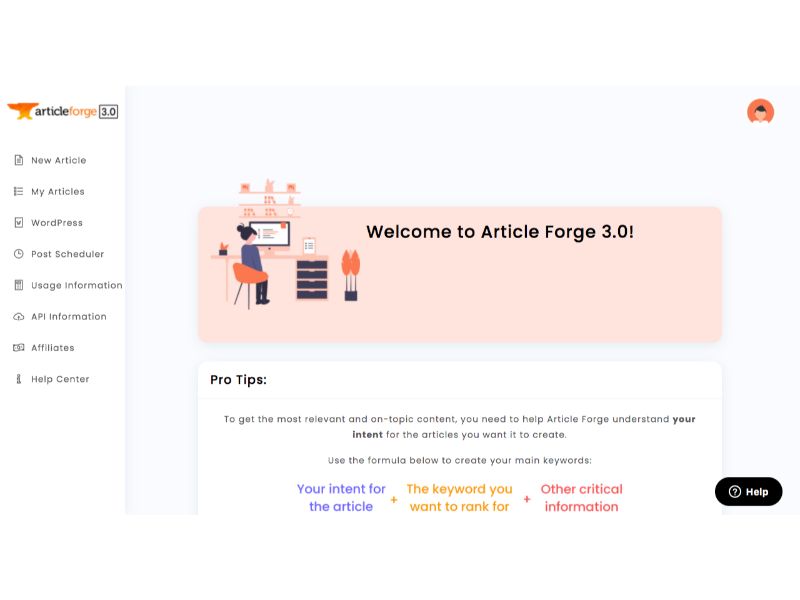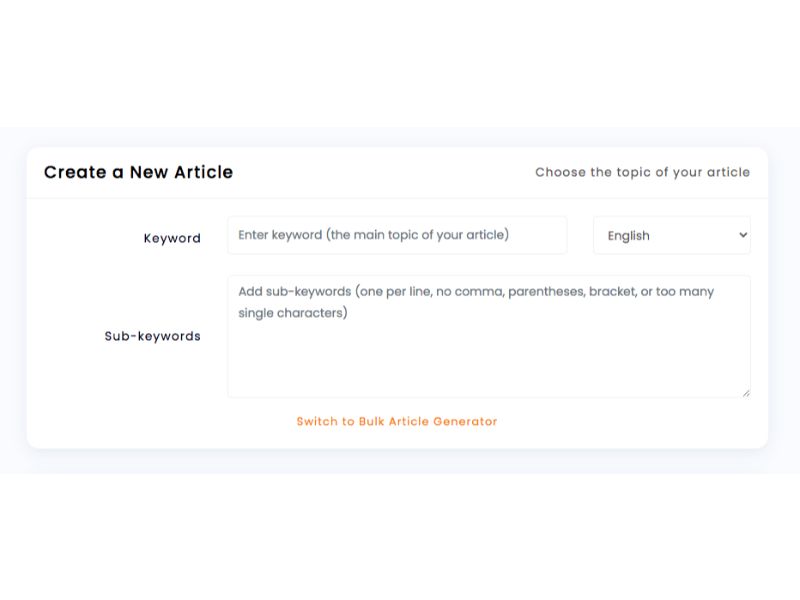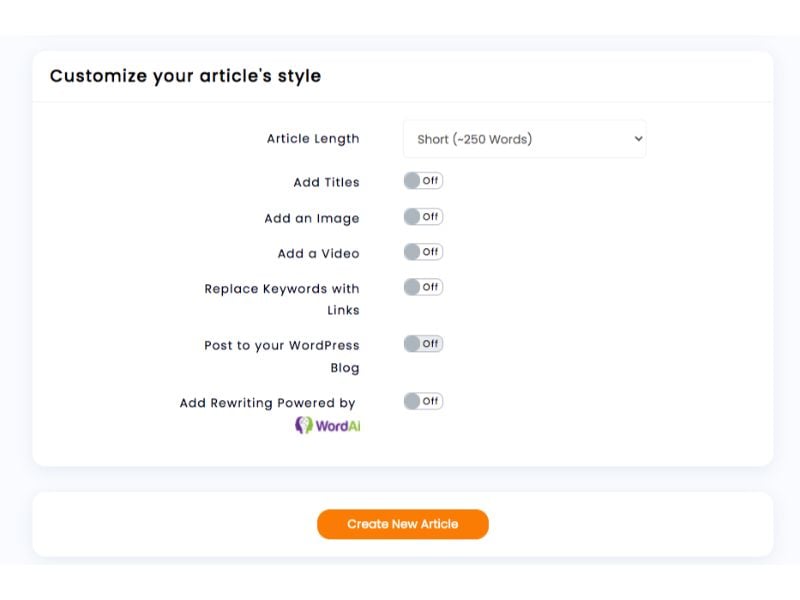
Writers possess a natural skepticism towards any service that tries to dethrone humans as the obvious choice for producing quality copy. In all honesty, it’s concerning. As AI technology continues to develop, more and more industries are seeing their workers riddled with anxiety over job security – and for good reason.
“Save time. Save money. Rank higher.”
Article Forge claims to solve a problem. Content is expensive and takes time to produce. Think about it: Content means content-writers. That means hiring a paid professional. Working with humans can be stressful— we get it. So, if we automate the process, we can produce more content for fewer resources. Right? Well, hypothetically, yes. If the technology is up to the task, AI-generated content might be a viable option for younger start-ups looking to improve their search engine ranking. Heck, even larger companies interested in skirting costs with their marketing team could be eyeing the services of businesses just like Article Forge. (Shameful, really.)
[in_content_ads gallery=”logos” logo=”on” title=”Need graphic design help?” subtitle=”Try Penji’s Unlimited Graphic Design and get all your branding, digital, print, and UXUI designs done in one place.” btntext=”Learn More” btnlink=”https://penji.co”]

Using the five-day free trial offered by Article Forge, we’ll provide a review of the service. To ensure a fair and equal fight, we will be providing Article Forge with a platform for rebuttal. Structurally, this will play out in the form of an interview. And I, as the human, will be the interviewer. But instead of Article Forge defending itself consciously, it will do so through a generated article— an article I’ve commissioned— detailing its own effectiveness.
The article will either support or refute its own claim. Without getting lost in the meta nature of it, the article will either justify itself– or it won’t.
This method of operations provides us with transparency.
Per my journalistic duty, I’ll be doing everything to provide you with a neutral exposition. An unbiased review of the work provided by the AI. But my inclusion of that work in this article will rid me of being the sole provider of the review. You will be able to read the work and come to your own conclusion. Any critique I add will then be relegated to a supplementary role. Simply, a guide through the article.
Initial impressions

The front page of the website looks legitimate enough. The typographic hierarchy is such that your eye is drawn to the words “High Quality”, highlighted in solid orange—the company’s primary color— and placed on the right-hand side of the screen. In the top left corner, we can see the brand’s combination mark.

Branding analysis
So, let’s use this as a chance to briefly dissect the logo. After all, the logo is a venture’s most important visual asset. Article Forge’s logo employs a simple approach. It uses two colors: black and orange. The pictorial mark is abstract. My initial perception is that of an origami anvil, though I don’t know how accurate that is. We reached out to Article Forge for a brief explanation of their logo but received no response. This isn’t an immediate drawback, however, as many brands succeed with abstract designs for a logo.
But there’s something off about the inclusion of the word “forge” in the title. Typically, it doesn’t help the authenticity or credibility of an entity to include a white-collar crime in the business name. Seems like a no-brainer.
“3.0” follows the company name at the top of the page. The 3.0 was rolled out in late 2021, per a blog post published in November of the same year.
Webpage design

This page employs minimal usage of black text over top of a white backdrop, with intersperses of a gradient orange. But this orange isn’t placed randomly; it’s reserved for important buzzwords. Laced throughout the page are expressions like Absolutely Free, Artificial Intelligence, Unique Content, Human, and Cost, all of which possess this orange hue. This type of reliance upon buzzwords just screams inauthentic. It assumes the viewer is already doubtful about the company’s effectiveness, and, as a result, is quick with cheap eye grabs and tacky junk mail slogans. Whether or not this speaks to the quality of the AI text generator is unclear– but it isn’t looking good.
The whole left side of the page is dedicated to a clickable image. Upon clicking, you’re greeted by a pop-up; an embedded youtube video. As it plays, a list of questions rattle off, to which you are expected to respond with a resounding yes. It’s reminiscent of the kind of commercial you would see flickering on the face of an embittered and vulnerable protagonist during the turning point of a bad film.
“Are you sick of wasting countless hours coming up with and writing content yourself? Paying hundreds or even thousands of dollars on expensive content? Waiting days or even weeks to get content from your writers?”
And then, with the viewer on bated breath, it makes its big claim:
“Article Forge delivers unique, SEO-optimized, high-quality content with the click of a button.”
What plans does Article Forge offer?
Okay– let’s say you’ve bitten. Your interest is piqued to the point of creating a membership and checking out the free trial. First, you’ll be tasked with choosing a plan.
Article Forge offers two plans: standard and unlimited.
Both tiers offer the primary functions of the service: All content is AI-generated, and must successfully pass through Copypaste— an online plagiarism detection service– before being delivered to you. You can choose to have the article published directly to your blog. Both plans offer the “bulk generator” tool, which we’ll discuss further in the next segment.
The only discernable difference between the tiers is the monthly word limit. The standard tier caps off at 250,000 words per month. The unlimited tier offers, well, an infinite production of articles.
How Does Article Forge Work?
This segment of the article will outline the process as it relates to the user interface, and how you actually operate the service. It won’t spend any time focusing on the actual technology being deployed.

Once you create a membership, you land on your profile page. On your left-hand side, tabs are neatly filed.
Creating a new article

The new article tab is where the creation happens. The “keyword” section allows you to input the main topic for your article. The generator will likely create a headline out of this, though you can adjust it after the fact. There’s a limit of 5 sub-keywords you can input. If you add any more than that, it will randomly choose five to work with. Additionally, any long-tail keyword longer than 50 words will be omitted. So, if you work within these constraints, you’re good to go.

Article Forge gives you options in regard to its formatting. As you can see above, you have control over the general length of the article. Options are as follows:
Very Short (~50 words)
Short (~250 words)
Medium (~500 words)
Long (~750 words)
In addition to the text itself, Article Forge offers the ability to add photos and videos to your article. The search engine algorithms favor articles that include links (both internal and external) and photos. With Article Forge, you can choose to have your keywords embedded with links. This is certainly a helpful trick.
In the third and fourth tab on your profile page, you can actually program Article Forge to work in tandem with your company’s WordPress. These tabs allow you to either publish directly to WordPress or schedule a specific time for future publishing.
Opening Statement: Why AI is The Superior Content Writer

The primary argument for Article Forge’s existence is laid out in one of their blog posts. A blog post aptly titled, “The Risks Of Hiring Freelance Writers And What You Can Do About Them.” It’s worth noting that this article, like every other article on their blog, is written by a genuine human. Let this speak volumes.
In this article, they outline their argument:
Humans run over budget
Fleshing out a content-production team can be an expensive task. Article Forge warns against the services of freelancers who offer extremely cheap content, citing their grammar, readability, and uniqueness of style as potentially lacking.
Article Forge flaunts its cost-effectiveness relative to these cheap-content freelancers. Its pricing model is based on a flat monthly subscription fee that, as the article puts it, works out to mere pennies per long-form article. And this is far more affordable than freelance writer costs.
Humans run behind schedule
Another upside to Article Forge is its reliability. A content marketing team composed entirely of people will fall subject to peopleness. For more experienced, deadline-driven professionals, you’ll certainly have to pay a premium.
Some content writers take days or even weeks to produce good content. Article Forge can produce a full piece of content in about one minute. Additionally, it offers a bulk generator. This tool creates multiple versions of the same document, giving you options to choose from in less time than a freelancer takes to produce one draft.
Humans have low-quality control
Even with a thorough vetting process, screening for the best candidates, you’re still risking low quality or unusable content. The launch of 3.0 has made Article Forge the only AI text generator capable of producing consistent, factually accurate content.
Article Forge prides itself on being far more predictable than a rotating cast of freelancers. The self-description that concludes the blog is perhaps the most succinct rendering of how they see their service:
“Article Forge may not yet be able to reach the highest highs in quality that human writers can, but it does not stoop to the lowest lows.”
Opening Statement: In Defense of Humans

Article Forge boldly claims that their elite team of researchers have developed the only tool to produce well-written, AI-generated content. Industry-specific content that actually makes sense, all without the tool of a ticking mind. While certain practices like car-making and welding have seen an increase in their use of robots for decades, there isn’t the same humanistic quality to those industries. There is no market of high-end collectors willing to pay an insane premium for handmade automobiles, the way there is in, for example, furniture making.
Certain industries see no real quality drop with automated processes. Oftentimes, their products are machines, faceless mechanical contraptions whose services don’t posture as being of human creation– so, it’s not offensive when they’re produced by machines themselves.
The Intangibles
The fundamental characteristics of people, the essence of humanity: imperfection, variable, uncertainty, and anxiety, are those we wouldn’t greet warmly in an automobile. We look to those things for stability. For security. And there’s just something gloriously insecure about humans. There’s a case to be made that the most powerful of human creations are those born from our innate flaw, and the triumphant anxiety we possess in reaction to that flaw. Art is the culmination of this anxiety.
Writing– even SEO-optimized content writing– is, in essence, an art. As Andy Warhol’s mid-70s aphorism goes: “Being good in business is the most fascinating kind of art. Making money is art and working is art and good business is the best art.”
The process of articulation, expression, and communication, is a truly human one– one not easily synthesized. It’s okay for these things to be difficult. It’s also okay to pay the people who have dedicated their lives to the craft of making these specific things easier.
Preface to The Interview
Article Forge produces content based on the information you feed it. For transparency’s sake, I’ve included all of the keywords and sub-keywords, placed conveniently below each response. The resulting text is cut and pasted from the generator without edit or revision. I have created questions that match the generated text to model a cohesive interaction.
I ask a question, and its response follows. We’re synthesizing a human interview, but your assessment of the generator’s content should be in regards to the text itself, not how clearly it responds to my question.
The Interview

Okay, hey. Thanks for taking the time to do this interview on such short notice, Arty– can I call you Arty? Alright, I’ll get right to it.
First off, can you tell me a little bit about yourself?
Article Forge works like any other article generator. You enter a keyword phrase, the length of the article, and the headlines. In 60 seconds, it generates high-quality articles. You can subscribe monthly or yearly. You can pay via PayPal, credit card, or Google Wallet. You can try out the service free for five days. If you decide not to keep the software, you can always get a refund within 30 days.
If you want to write articles for your website, you can use Article Forge to generate them. It generates unique articles for each keyword and subkeyword combination. Once you submit the article, the program will choose a random posting time for you to post it. Once you’ve published an article, you can continue using it for as long as you’d like. And it won’t cost you a dime. And it’s free.
Keywords for article: Article Forge, Artificial Intelligence, Human Being, Effectiveness, Quality, Creativity.
Can you talk a little bit about the history and development of Article Forge?
The history of Article Forge is an interesting one, as it is important for anyone who wants to write about something online. The software can do almost any task, and it is the most convenient tool for this. It generates articles based on content found on the web, using the same keywords. The new features of this software include video and image capabilities. This is a great way to boost the visibility of your articles and improve their search engine ranking.
Unlike other article writing services, the artificial intelligence used by Article Forge is highly effective at creating high-quality content. This software can be trained using the same artificial intelligence that Google uses to write articles. Moreover, the program can generate thousands of articles in a few minutes, which is great for busy people. The software can also help you save money by eliminating the need to hire a writer. The free trial period lasts for five days.
Keywords for article: History of Article Forge, How Did Article Forge Start?, How Did Article Forge Develop?, What Is Article Forge 3.0?, How Is Article Forge Different?
Do you think Article Forge is superior to human content writers?
The AI writers at Article Forge are trained with millions of articles. These AI writers naturally generate SEO-friendly content for your website. This helps you create more content on your website more quickly. Writing articles from scratch is a time-consuming and tedious process. Moreover, the quality of your content may vary depending on the author. It is highly recommended that you hire a human writer for this task.
When hiring an article writer, you should check out the quality of the article. Although freelancers are expensive, they can be extremely reliable. Moreover, they can work faster than Article Forge. In addition, they don’t have the same level of experience as a human, which makes them the ideal candidate for this job. Once you choose the right one, you can be sure that your content will be high-quality.
Keyword for article: Why Is Article Forge Better Than A Freelancer?, Human Being, Freelancer, Article Forge, Productive, Effective.
I don’t want to be accused of twisting your words, Arty, but it looks like you’re actually supporting human writers over AI writers. In fact, it looks like you’re downright doubtful about your own effectiveness.
You must not think Article Forge, in its current iteration, is at risk of displacing human content writing jobs?
AI and automation will not completely replace human jobs, but the technology will create new ones. As a result, humans will be less needed. However, there are already several types of new jobs created by AI. These jobs may be in different industries, but will be necessary in many ways. Some of these jobs include: manufacturing, construction, and sales. Here are some of the possible scenarios: 1. Artificial intelligence (AI) will be the primary driver of job creation.
Keywords for article: Is AI Displacing Human Jobs?
Alright. Thanks.
Conclusion

Okay, maybe it was a little too easy to outsmart the technology. But three things are clear here:
- The AI text generator creates an article by quickly combing through millions of pieces of content already published to the internet. And we literally asked it to write an article about an AI text generator. So, because ol’ Arty is programmed to sift through the web— and there’s certainly a slew of web content discrediting AI text generators— the final product is going to reflect a negative sentiment. We essentially tricked the machine into disputing itself by, well, doing its job. This is the AI equivalent of the “stop hitting yourself” game you’ve seen schoolyard bullies doing to a helpless classmate. But it also proves that there is a consensus in the writing world: content production is a human task.
- Self-mutiny aside, the content is rather poor. Noticeably poor, in fact. The sentences seem strung together without awareness, indifferent to where they stand relative to the previous one. I squirm when I read three consecutive sentences, all starting with the word “you.” It’s jagged, clunky, and repetitious without effect. Some sentences even directly contradict the one directly before it. In certain cases, two adjacent sentences essentially repeat themselves using slightly different words. I audibly laughed when I read, “And it won’t cost you a dime. And it’s free.” Because no (well-adjusted) person speaks in this way. Certainly no professional writer. It’s likely done in an effort to meet the prescribed word count. If that’s not on par with the “lowest lows” in human writing, I’m not sure what is.
- The work sits in a strange in-between ground. The AI-generated text is generally clear. It understands, for the most part, what the assignment is, and can create a relatively coherent article about whatever you ask it to. But there’s an awkward, uneven characteristic element to it. Not to mention some glaring grammatical atrocities. It’s almost right. As a result, it falls into the uncanny valley of prose. Human beings, even those without extensive writing experience, can sense the uneasiness.
Does Google care?

We can understand why some might be intrigued by an AI content writer. I mean, it’s a low-cost, automated alternative to SEO content creation. On the face of it, this feels like a potential home run idea. But it’s clear that the corner-cutting practice is reflected in the work’s quality.
So here’s an important question: Do search engines care if the writing is subpar and robotic? Especially if the information is distributed in a way that otherwise appeases the algorithm. It’s difficult to answer this question concretely. The algorithms change all the time. But one thing is consistent; search engines favor content written for humans. And when humans sense the uncanny valley type of writing style, they’re likely to turn away. Because it sounds like it’s being written according to an SEO-approved checklist, and, as a result, lacks the complex layered emotion of human readers.
People respond positively to humanity. Character and uniqueness of personality are invaluable assets in the work of writers. This goes for any genre. So, if you can swing it, your business and its SEO ranking will benefit from the voice of a human content writer. Let my interview with Arty act as a cautionary tale; an example of where AI text generators stand at the present moment.
But hey, maybe Article Forge 4.0 will change the game.
Here’s to hoping. But in the meantime, let Penji assist you in your search for quality creatives.











